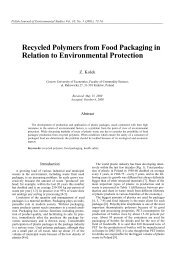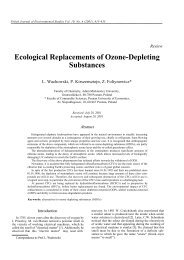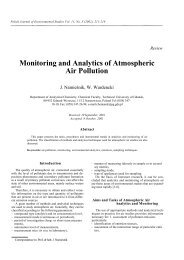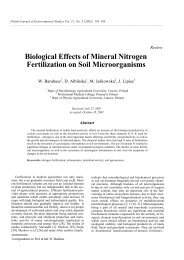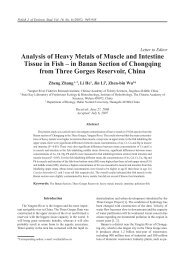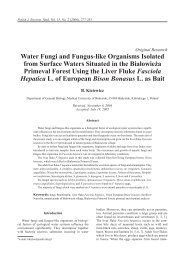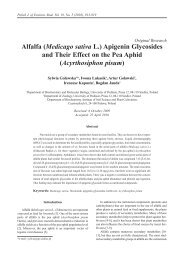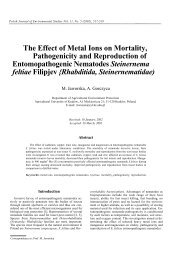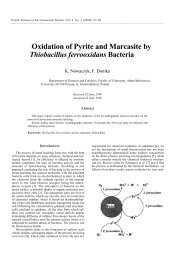Occurrence of Chlorite, Chlorate and Bromate in Disinfected ...
Occurrence of Chlorite, Chlorate and Bromate in Disinfected ...
Occurrence of Chlorite, Chlorate and Bromate in Disinfected ...
Create successful ePaper yourself
Turn your PDF publications into a flip-book with our unique Google optimized e-Paper software.
Polish J. <strong>of</strong> Environ. Stud. Vol. 16, No. 2 (2007), 237-241<br />
Orig<strong>in</strong>al Research<br />
<strong>Occurrence</strong> <strong>of</strong> <strong>Chlorite</strong>, <strong>Chlorate</strong> <strong>and</strong> <strong>Bromate</strong> <strong>in</strong><br />
Dis<strong>in</strong>fected Swimm<strong>in</strong>g Pool Water<br />
R. Michalski*, B. Mathews<br />
Institute <strong>of</strong> Environmental Eng<strong>in</strong>eer<strong>in</strong>g <strong>of</strong> Polish Academy <strong>of</strong> Science, 34 Sklodowska-Curie Str., 41-819 Zabrze, Pol<strong>and</strong><br />
Received: June 29, 2006<br />
Accepted: November 10, 2006<br />
Abstract<br />
Swimm<strong>in</strong>g pool water treatment <strong>in</strong> general <strong>in</strong>cludes flocculation, s<strong>and</strong> filtration <strong>and</strong> subsequent dis<strong>in</strong>fection.<br />
<strong>Chlorite</strong>, chlorate <strong>and</strong> bromate are dis<strong>in</strong>fection by-products <strong>of</strong> swimm<strong>in</strong>g pool water treated by<br />
chlor<strong>in</strong>e species or ozone. They are responsible for adverse effects on human health <strong>and</strong> their analyses <strong>in</strong><br />
swimm<strong>in</strong>g pool water are necessary.<br />
The simply <strong>and</strong> fast suppressed ion chromatography simultaneous separation <strong>and</strong> conductivity determ<strong>in</strong>ation<br />
<strong>of</strong> chlorite, chlorate, bromate, fluoride, chloride, nitrate, bromide, phosphate <strong>and</strong> sulfate <strong>in</strong> dis<strong>in</strong>fected<br />
swimm<strong>in</strong>g pool water has been described. The separation was performed on an anion-exchange<br />
column with 1.0 mM Na 2<br />
CO 3<br />
+ 3.2 mM NaHCO 3<br />
as eluent, <strong>and</strong> determ<strong>in</strong>ation by suppressed conductivity<br />
detection.<br />
<strong>Chlorite</strong> has been found <strong>in</strong> 5 analyzed samples, chlorate <strong>in</strong> all <strong>of</strong> them, <strong>and</strong> bromate <strong>in</strong> the 2 samples<br />
orig<strong>in</strong>ated from ozonated swimm<strong>in</strong>g pool water. Ions were analyzed <strong>in</strong> the wide concentrations range<br />
from 0.05 mg L -1 (bromate) up to 300 mg L -1 (chloride, sulfate). L<strong>in</strong>earity <strong>of</strong> dis<strong>in</strong>fection by-products was<br />
checked up to 2.0 mg/L (chlorite), 30 mg L -1 (chlorate) <strong>and</strong> 0.5 mg L -1 (bromate) with a 50 µL <strong>in</strong>jection<br />
loop (r 2 = 0.9966 – 0.9985), respectively. Fluoride, chloride, nitrate, bromide, phosphate, <strong>and</strong> sulfate did not<br />
<strong>in</strong>terfere with target anions.<br />
The detection limits <strong>of</strong> ClO 2-<br />
, ClO 3<br />
-<br />
<strong>and</strong> BrO 3<br />
-<br />
were on the levels: 0.19 mg L -1 , 0.69 mg L -1 <strong>and</strong> 0.006<br />
mg L -1 , respectively. The mean recoveries <strong>of</strong> target anions for spiked samples were 85% – 110% <strong>and</strong> coefficient<br />
<strong>of</strong> variation <strong>of</strong> analyzed anions do not exceed 4.72%. The concentrations <strong>of</strong> <strong>in</strong>organic dis<strong>in</strong>fection<br />
by-products differ from 0.31 mg L -1 up to 31.92 mg L -1 .<br />
Keywords: chlorite; chlorate; bromate; ion chromatography; swimm<strong>in</strong>g pool water<br />
Introduction<br />
*Correspond<strong>in</strong>g author; e-mail: michalski@ipis.zabrze.pl<br />
Swimm<strong>in</strong>g pool water needs to be dis<strong>in</strong>fected to keep<br />
swimmers from <strong>in</strong>fections caused by microbial pathogens.<br />
Traditionally, sodium hypochlorite, chlor<strong>in</strong>e dioxide or<br />
gaseous chlor<strong>in</strong>e has been widely used for this purpose.<br />
Unfortunately, the uses <strong>of</strong> these compounds have been<br />
reported to produce various halogenated organic compounds,<br />
s<strong>in</strong>ce organic materials <strong>of</strong> various forms (perspiration,<br />
ur<strong>in</strong>e, mucus, sk<strong>in</strong> particles, hair, lotion, etc.) are<br />
released <strong>in</strong>to swimm<strong>in</strong>g pool water by swimmers [1]. In<br />
addition, most pool waters are supplied with chlor<strong>in</strong>ated<br />
surface water already contam<strong>in</strong>ated with dis<strong>in</strong>fection byproducts.<br />
In this connection extensive research for alternative<br />
dis<strong>in</strong>fection methods such as ozonation has been<br />
developed.<br />
The ma<strong>in</strong> hazardous <strong>in</strong>organic oxyhalide dis<strong>in</strong>fection<br />
by-products are: bromate, chlorite <strong>and</strong> chlorate. The<br />
ozonation <strong>of</strong> water conta<strong>in</strong><strong>in</strong>g bromide can cause the<br />
formation <strong>of</strong> bromate [2]. <strong>Chlorite</strong> is formed when chlo-
238<br />
r<strong>in</strong>e dioxide is used [3], whereas chlorate is formed when<br />
chlor<strong>in</strong>e, chlor<strong>in</strong>e dioxide, hypochlorite or chloram<strong>in</strong>e is<br />
used to dis<strong>in</strong>fect raw water [4]. Chlor<strong>in</strong>e dioxide oxidizes<br />
the organic matter under the formation <strong>of</strong> chlorite, which<br />
can be oxidized to chlorate by ozone or hypochlorite if a<br />
comb<strong>in</strong>ation <strong>of</strong> chlor<strong>in</strong>e dioxide <strong>and</strong> these dis<strong>in</strong>fectants<br />
is used.<br />
<strong>Chlorite</strong>, chlorate <strong>and</strong> <strong>in</strong> particular bromate have potential<br />
harmful effects for human be<strong>in</strong>gs. The International<br />
Agency for Research on Cancer (IARC) has concluded<br />
that chlorite is not classifiable as to its carc<strong>in</strong>ogenicity to<br />
humans, though it may cause hemolytic anemia <strong>and</strong> allergic<br />
dermatitis [5].<br />
Although the database for chlorate is less extensive than<br />
that for chlorite, it is known that the primary concern with<br />
chlorate is oxidative damage to red blood cells, <strong>and</strong> more<br />
toxic than free chlorate ions are their metabolites [6].<br />
Next, bromate has been identified as an animal <strong>and</strong><br />
possible human carc<strong>in</strong>ogen [7]. IARC classified bromate<br />
<strong>in</strong>to group B-2 as the agent is possibly carc<strong>in</strong>ogenic to<br />
humans [8]. The United States Environmental Protection<br />
Agency [9], as well as the Commission <strong>of</strong> the European<br />
Communities [10], have recently issued new rules that require<br />
public water supplies to control previously unregulated<br />
microorganisms <strong>and</strong> cancer-caus<strong>in</strong>g dis<strong>in</strong>fection byproducts<br />
<strong>in</strong> f<strong>in</strong>al treatment <strong>of</strong> dr<strong>in</strong>k<strong>in</strong>g water. Maximum<br />
Contam<strong>in</strong>ant Level (MCL) for bromate is 10 µg L -1 . <strong>Chlorite</strong><br />
MCL is regulated only <strong>in</strong> the US EPA guidel<strong>in</strong>es <strong>and</strong><br />
is on the level <strong>of</strong> 1000 µg L -1 .<br />
The World Health Organization has published the<br />
guidel<strong>in</strong>e value <strong>of</strong> 700 µg L -1 for chlorite <strong>and</strong> chlorate <strong>in</strong><br />
dr<strong>in</strong>k<strong>in</strong>g water [6]. However, WHO recommends m<strong>in</strong>imiz<strong>in</strong>g<br />
the level <strong>of</strong> chlorate as long as there is no reliable<br />
toxicological data.<br />
This is a reason why chlorite, chlorate <strong>and</strong> bromate<br />
should be regularly monitored not only <strong>in</strong> dr<strong>in</strong>k<strong>in</strong>g water,<br />
but also <strong>in</strong> swimm<strong>in</strong>g pool water.<br />
The determ<strong>in</strong>ation <strong>of</strong> common <strong>in</strong>organic anions <strong>and</strong><br />
cations usually was carried out us<strong>in</strong>g chemical wet methods<br />
such as: gravimetry, titration, photometry, turbidimetry<br />
<strong>and</strong> colorimetry. Many <strong>of</strong> these methods suffer<br />
from <strong>in</strong>terferences <strong>and</strong> limited sensitivity; they can be<br />
labour <strong>in</strong>tensive <strong>and</strong> are <strong>of</strong>ten difficult to automate.<br />
Recently the commonly used analytical method for<br />
the determ<strong>in</strong>ation <strong>of</strong> <strong>in</strong>organic anions <strong>and</strong> cations is ion<br />
chromatography, which has almost replaced most <strong>of</strong> the<br />
wet chemical methods used <strong>in</strong> water <strong>and</strong> waste water<br />
analyses [11].<br />
There are several ion chromatographic st<strong>and</strong>ards for<br />
<strong>in</strong>organic anion determ<strong>in</strong>ation, <strong>in</strong>clud<strong>in</strong>g dis<strong>in</strong>fection<br />
by-products such as: chlorite, chlorate <strong>and</strong> bromate recommended<br />
by ISO [12, 13], US EPA [14-17] <strong>and</strong> by ion<br />
chromatography manufactures such as Dionex [18, 19]<br />
<strong>and</strong> Metrohm [20].<br />
These methods are designed for the determ<strong>in</strong>ation<br />
<strong>of</strong> <strong>in</strong>organic dis<strong>in</strong>fection by-products ma<strong>in</strong>ly <strong>in</strong> samples<br />
with simply matrix, such as dr<strong>in</strong>k<strong>in</strong>g water. Swimm<strong>in</strong>g<br />
pool water is a complex matrix due to the high content<br />
Michalski R., Mathews B.<br />
<strong>of</strong> chloride <strong>and</strong> sulfate, whose concentration can exceed<br />
1000 mg L -1 . Outdoor <strong>and</strong> <strong>in</strong>door swimm<strong>in</strong>g pools are<br />
popular places <strong>of</strong> human rest <strong>and</strong> activity. In this connection<br />
their monitor<strong>in</strong>g is necessary.<br />
This work describes an isocratic suppressed ion chromatography<br />
method for the simultaneous determ<strong>in</strong>ation<br />
<strong>of</strong>: F - , ClO 2-<br />
, BrO 3-<br />
, Cl - , Br - , ClO 3-<br />
, NO 3-<br />
, PO 4<br />
3-<br />
<strong>and</strong><br />
SO 4<br />
2-<br />
<strong>in</strong> several <strong>in</strong>door swimm<strong>in</strong>g pools water treated by<br />
chlor<strong>in</strong>e species or ozone. The occurrence <strong>of</strong> <strong>in</strong>organic<br />
by-products depend<strong>in</strong>g on dis<strong>in</strong>fection agents used is <strong>in</strong>vestigated.<br />
Experimental Procedures<br />
Instrumentation<br />
Ion chromatographic separations were performed on<br />
Metrohm ion chromatography system (Herisau Metrohm<br />
AG, Switzerl<strong>and</strong>) consist<strong>in</strong>g <strong>of</strong>: 818 IC Pump, 837 IC Eluent<br />
Degasser, 830 IC Interface, 820 IC Separation Center,<br />
Rheodyne <strong>in</strong>jection valve, Metrodata 2.3 s<strong>of</strong>tware, autosampler<br />
(838 Advanced Sample Processor), MSM suppressor,<br />
conductivity detector (819 IC) <strong>and</strong> 50 µL sample<br />
<strong>in</strong>jection loop.<br />
Reagents <strong>and</strong> Procedures<br />
Analytical grade <strong>of</strong> Na 2<br />
CO 3<br />
<strong>and</strong> NaHCO 3<br />
used for eluent<br />
preparation <strong>and</strong> 95% H 2<br />
SO 4<br />
as a regenerant solution<br />
were obta<strong>in</strong>ed from Fluka (Fluka, Ste<strong>in</strong>heim, Switzerl<strong>and</strong>).<br />
St<strong>and</strong>ard solutions <strong>of</strong> <strong>in</strong>organic anions were prepared<br />
by dissolv<strong>in</strong>g a suitable amount <strong>of</strong> salt <strong>in</strong> deonized<br />
water.<br />
Analytical grades <strong>of</strong> KF, NaCl, NaClO 2<br />
, NaClO 3<br />
,<br />
KBrO 3<br />
, NaNO 3<br />
, KBr, K 3<br />
PO 4<br />
<strong>and</strong> Na 2<br />
SO 4<br />
were purchased<br />
from Fluka (Fluka, Ste<strong>in</strong>heim, Switzerl<strong>and</strong>). Water used<br />
<strong>in</strong> the experiments was purified us<strong>in</strong>g Millipore equipment<br />
(Millipore, Bedford, MA, USA) <strong>and</strong> had an electrical<br />
conductivity < 0.05 µS cm -1 .<br />
All st<strong>and</strong>ard solutions were stored <strong>in</strong> a refrigerator at<br />
2°C to 8°C. Calibration solutions <strong>of</strong> analyzed <strong>in</strong>organic<br />
anions were prepared by dilut<strong>in</strong>g the stock st<strong>and</strong>ard solution<br />
to the required concentration just before use.<br />
Method Optimization<br />
Because <strong>of</strong> the high ratio <strong>of</strong> the concentration <strong>of</strong> chloride<br />
<strong>and</strong> sulfate to other anions, analytical conditions must<br />
be chosen carefully <strong>in</strong> order to simultaneous separation<br />
<strong>and</strong> detection <strong>of</strong> 9 anions <strong>in</strong> one run.<br />
An anion-exchange column from Metrohm (Metrosep<br />
A Supp 5-250 x 4.0 mm I.D) <strong>in</strong> connection with<br />
Transgenomic Cetac 300 precolumn (100 x 7.8 mm I.D.)<br />
was used. With<strong>in</strong> the conf<strong>in</strong>es <strong>of</strong> method optimalization,<br />
two eluent concentrations (1.7 mM Na 2<br />
CO 3<br />
+ 1.5 mM
<strong>Occurrence</strong> <strong>of</strong> <strong>Chlorite</strong>... 239<br />
NaHCO 3<br />
<strong>and</strong> 1.0 mM Na 2<br />
CO 3<br />
+ 3.2 mM NaHCO 3<br />
), <strong>and</strong><br />
two eluent flow rates (0.7 mL m<strong>in</strong> -1 or 1.0 mL m<strong>in</strong> –1 )<br />
were tested. The best chromatographic performances<br />
proved for 1.0 mM Na 2<br />
CO 3<br />
+ 3.2 mM NaHCO 3<br />
eluent<br />
with 0.7 mL m<strong>in</strong> -1 flow rate.<br />
Calibration <strong>and</strong> Method Validation<br />
Validation based on ISO guidel<strong>in</strong>es [21] was carried<br />
out <strong>in</strong> the ion chromatography method with responses<br />
for peak areas collected <strong>and</strong> evaluated. 10 calibration<br />
solutions <strong>of</strong> analyzed <strong>in</strong>organic anions prepared <strong>in</strong><br />
deonized water were <strong>in</strong>jected <strong>in</strong>to the eluent stream.<br />
The concentration ranges have been chosen accord<strong>in</strong>g<br />
to the expected concentrations <strong>of</strong> analyzed anions <strong>in</strong><br />
swimm<strong>in</strong>g pool waters. All calibration solutions were<br />
analyzed <strong>in</strong> triplicate under optimized chromatographic<br />
conditions.<br />
The calibration curve cover<strong>in</strong>g the concentration<br />
range was obta<strong>in</strong>ed <strong>and</strong> the l<strong>in</strong>ear relationship between<br />
peak area <strong>and</strong> concentration were experimentally verified.<br />
L<strong>in</strong>earity <strong>of</strong> dis<strong>in</strong>fection by-products was checked up to<br />
2.0 mg L -1 (chlorite), 30 mg L -1 (chlorate) <strong>and</strong> 0.5 mg L -1<br />
(bromate). Common <strong>in</strong>organic anions (fluoride, chloride,<br />
nitrate, bromide, phosphate, <strong>and</strong> sulfate) did not <strong>in</strong>terfere<br />
with target anions.<br />
The accuracy <strong>of</strong> the method was evaluated from recovery<br />
assays, prepar<strong>in</strong>g samples spiked with Reference<br />
St<strong>and</strong>ard Solution (AccuIon TM , NIST, USA). The Limit <strong>of</strong><br />
Detection (LOD) <strong>and</strong> the Limit <strong>of</strong> Quantification (LOQ)<br />
were calculated as six <strong>and</strong> ten times, respectively, the ratio<br />
between the st<strong>and</strong>ard deviation <strong>of</strong> the regression <strong>and</strong> the<br />
slope <strong>of</strong> the calibration l<strong>in</strong>e. Selected method validation<br />
parameters are listed <strong>in</strong> Table 1.<br />
Results<br />
Determ<strong>in</strong>ation <strong>of</strong> <strong>Chlorite</strong>, <strong>Chlorate</strong>, <strong>Bromate</strong> <strong>and</strong><br />
Six Common Inorganic Anions <strong>in</strong> Swimm<strong>in</strong>g Pool<br />
Water<br />
The target anions were determ<strong>in</strong>ed <strong>in</strong> water samples<br />
taken from 7 <strong>in</strong>door swimm<strong>in</strong>g pools. In the pools under<br />
<strong>in</strong>vestigation, dis<strong>in</strong>fection <strong>of</strong> the water was carried out either<br />
by gaseous chlor<strong>in</strong>e, chlor<strong>in</strong>e dioxide or hypochlorite<br />
solution (5 swimm<strong>in</strong>g pools) or with ozone (2 swimm<strong>in</strong>g<br />
pools). After sampl<strong>in</strong>g, samples were kept <strong>in</strong> the dark at<br />
+4°C <strong>and</strong> were analyzed with<strong>in</strong> 48 hours.<br />
Two samples – one from swimm<strong>in</strong>g pool water dis<strong>in</strong>fected<br />
with chlor<strong>in</strong>e dioxide <strong>and</strong> one by ozone – were<br />
chosen for recovery study. The analyses were carried out<br />
by spik<strong>in</strong>g the samples with ClO 2-<br />
, ClO 3<br />
-<br />
<strong>and</strong> BrO 3<br />
-<br />
<strong>in</strong> concentrations<br />
<strong>of</strong> 0.2 or 5.0 mg L -1 , respectively. The results<br />
are listed <strong>in</strong> Table 2. An example <strong>of</strong> chromatogram obta<strong>in</strong>ed<br />
for sample no.3 spiked with 0.2 mg L -1 <strong>of</strong> chlorite,<br />
bromate <strong>and</strong> chlorate is shown <strong>in</strong> Fig. 1.<br />
Table 1. Method validation parameters.<br />
Parameter<br />
-<br />
ClO 2<br />
-<br />
ClO 3<br />
-<br />
BrO 3<br />
F - Cl - Br - -<br />
NO 3<br />
3-<br />
PO 4<br />
2-<br />
SO 4<br />
Concentration range [mg L -1 ] 0.2-2.0 3-30 0.05-0.5 0.2-2.0 30-300 0.2-2.0 2-20 0.2-2.0 30-300<br />
St<strong>and</strong>ard deviation [mg L -1 ] 0.08 0.31 0.003 0.04 0.69 0.06 0.28 0.43 0.44<br />
Coefficient <strong>of</strong> variation [%] 3.09 3.12 4.72 1.37 2.53 2.04 2.62 2.73 1.60<br />
Limit <strong>of</strong> detection [mg L -1 ] 0.19 0.69 0.006 0.08 1.57 0.12 0.65 0.97 0.99<br />
Limit <strong>of</strong> quantification [mg L -1 ] 0.57 2.07 0.018 0.24 4.71 0.36 1.95 2.91 2.97<br />
Regression coefficient (r 2 ) 0.9966 0.9985 0.9967 0.9997 0.9989 0.9983 0.9990 0.9993 0.9996<br />
Table 2. Recoveries <strong>of</strong> chlorite, chlorate <strong>and</strong> bromate from spiked samples, (n=3).<br />
Sample<br />
No<br />
3<br />
7<br />
Added [mg L -1 ]<br />
Found<br />
[mg L -1 ]<br />
ClO 2<br />
-<br />
ClO 3<br />
-<br />
BrO 3<br />
-<br />
Recovery<br />
[%]<br />
Found<br />
[mg L -1 ]<br />
Recovery<br />
[%]<br />
Found<br />
[mg L -1 ]<br />
Recovery<br />
[%]<br />
0.20 + 0.18 90 + 0.21 105 + 0.22 110<br />
5.00 + 4.56 91 + 4.83 97 + 5.27 105<br />
0.20 + 0.21 105 + 0.18 90 + 0.17 85<br />
5.00 + 4.70 94 + 5.31 106 + 4.92 98<br />
“+” - additional amount <strong>of</strong> analyzed anion
240<br />
Michalski R., Mathews B.<br />
Fig. 1. Chromatogram <strong>of</strong> sample No. 3 spiked with 0.2 mg L -1 <strong>of</strong> chlorite, bromate <strong>and</strong> chlorate, respectively.<br />
Table 3. Quantitative results for 9 <strong>in</strong>organic anions <strong>in</strong> water samples from swimm<strong>in</strong>g pools [mg L -1 ] (n=3).<br />
Sample<br />
Dis<strong>in</strong>fection<br />
agent<br />
0.51<br />
1 ClO 2<br />
± 0.02<br />
2.53<br />
2 NaClO<br />
± 0.09<br />
0.31<br />
3 ClO 2<br />
± 0.02<br />
0.71<br />
4 ClO 2<br />
± 0.03<br />
1.60<br />
5 NaClO<br />
± 0.06<br />
6 O 3<br />
< LOD<br />
7 O 3<br />
< LOD<br />
ClO 2<br />
-<br />
ClO 3<br />
-<br />
BrO 3<br />
-<br />
F - Cl - Br - NO 3<br />
-<br />
PO 4<br />
3-<br />
SO 4<br />
2-<br />
22.23<br />
± 0.85<br />
31.92<br />
± 1.02<br />
23.14<br />
± 0.87<br />
21.73<br />
± 0.97<br />
29.23<br />
± 1.12<br />
3.21<br />
± 0.11<br />
2.14<br />
± 0.09<br />
< LOD<br />
< LOD<br />
< LOD<br />
< LOD<br />
< LOD<br />
0.08<br />
± 0.01<br />
0.511<br />
± 0.02<br />
0.28<br />
± 0.01<br />
0.38<br />
± 0.02<br />
0.98<br />
± 0.9<br />
0.33<br />
± 0.02<br />
0.23<br />
± 0.02<br />
2.43<br />
± 0.02<br />
0.72<br />
± 0.05<br />
213.71<br />
± 15.36<br />
396.11<br />
± 17.54<br />
275.04<br />
± 14.21<br />
415.27<br />
± 19.93<br />
213.71<br />
± 16.05<br />
135.56<br />
± 12.67<br />
116.23<br />
± 11.73<br />
1.13<br />
± 0.04<br />
0.60<br />
± 0.02<br />
1.58<br />
± 0.06<br />
0.53<br />
± 0.04<br />
0.44<br />
± 0.03<br />
0.09<br />
± 0.01<br />
< LOD<br />
4.17<br />
± 0.15<br />
5.53<br />
± 0.18<br />
4.85<br />
± 0.15<br />
5.71<br />
± 0.17<br />
9.25<br />
± 0.22<br />
16.25<br />
± 0.83<br />
26.34<br />
± 1.09<br />
0.18<br />
± 0.03<br />
2.28<br />
± 0.06<br />
0.38<br />
± 0.07<br />
1.53<br />
± 0.05<br />
0.18<br />
± 0.03<br />
1.82<br />
± 0.04<br />
2.28<br />
± 0.07<br />
145.58<br />
± 9.64<br />
185.97<br />
± 10.14<br />
245.81<br />
± 12.06<br />
266.96<br />
± 12.67<br />
145.58<br />
± 9.35<br />
105.48<br />
± 10.17<br />
98.34<br />
± 8.03<br />
All samples taken from swimm<strong>in</strong>g pools were filtered<br />
through 0.45 µm membrane filter, <strong>and</strong> were <strong>in</strong>jected <strong>in</strong>to<br />
the ion chromatograph directly. Each sample was run <strong>in</strong><br />
triplicate. The concentrations <strong>of</strong> analyzed anions <strong>in</strong>clud<strong>in</strong>g<br />
st<strong>and</strong>ard deviation are given <strong>in</strong> Table 3.<br />
Discussion <strong>of</strong> Results<br />
Accord<strong>in</strong>g to obta<strong>in</strong>ed results, the follow<strong>in</strong>g can be<br />
concluded:<br />
1. The health hazard risk for swimmers concerned with<br />
<strong>in</strong>organic dis<strong>in</strong>fection by-products (bromate, chlorite<br />
<strong>and</strong> chlorate) present <strong>in</strong> swimm<strong>in</strong>g pool water is common<br />
<strong>and</strong> significant. In this connection their analyses<br />
are necessary <strong>and</strong> swimmers should be <strong>in</strong>formed about<br />
water quality.<br />
2. The performance characteristics <strong>of</strong> the method were<br />
established by determ<strong>in</strong><strong>in</strong>g the follow<strong>in</strong>g validation parameters:<br />
precision <strong>and</strong> accuracy, l<strong>in</strong>earity, limit <strong>of</strong> detection<br />
<strong>and</strong> limit <strong>of</strong> quantification (Table 1). These data<br />
show that ion chromatography is convenient, sensitive,
<strong>Occurrence</strong> <strong>of</strong> <strong>Chlorite</strong>... 241<br />
reproducible, <strong>and</strong> can be used <strong>in</strong> the rout<strong>in</strong>e monitor<strong>in</strong>g<br />
<strong>of</strong> chlorite, chlorate, <strong>and</strong> bromate, as well as other common<br />
<strong>in</strong>organic anions <strong>in</strong> swimm<strong>in</strong>g pool water.<br />
3. Application <strong>of</strong> highly selective <strong>and</strong> high capacity anion-exchange<br />
column allows for simultaneously isocratic<br />
separation <strong>and</strong> determ<strong>in</strong>ation <strong>of</strong> 9 <strong>in</strong>organic anions<br />
<strong>in</strong> 25 m<strong>in</strong>utes <strong>in</strong> the presence <strong>of</strong> high content <strong>of</strong><br />
chloride <strong>and</strong> sulfate. The only sample treatment was<br />
filtration.<br />
4. The results <strong>of</strong> recovery test (Table 2) show that recovery<br />
<strong>of</strong> target anions is on the acceptable levels for<br />
environmental purposes (85-110%).<br />
5. <strong>Chlorite</strong> has been found <strong>in</strong> 5 samples, chlorate <strong>in</strong> all<br />
<strong>of</strong> them, <strong>and</strong> bromate only <strong>in</strong> the 2 samples orig<strong>in</strong>ated<br />
from ozonated swimm<strong>in</strong>g pool. Nevertheless its concentration<br />
was much higher than the imposed limit for<br />
dr<strong>in</strong>k<strong>in</strong>g water, though swimmers only <strong>in</strong>gest the pool<br />
water occasionally.<br />
6. Higher concentrations <strong>of</strong> chlorate were found to be<br />
associated with those pools us<strong>in</strong>g hypochlorite solution<br />
as a dis<strong>in</strong>fectant agent. In contrast, lower chlorate<br />
<strong>and</strong> chlorite concentration were found <strong>in</strong> pools treated<br />
with chlor<strong>in</strong>e dioxide. It is <strong>in</strong> good agreement with literature<br />
data [4, 22].<br />
7. At present, the efforts <strong>of</strong> high chlorate concentrations<br />
<strong>in</strong> analyzed samples are unclear. It is therefore strongly<br />
recommended that measures should be taken to reduce<br />
chlorate level <strong>in</strong> swimm<strong>in</strong>g pool water.<br />
8. In further study the stability <strong>of</strong> the <strong>in</strong>organic dis<strong>in</strong>fection<br />
by-products <strong>and</strong> changes <strong>of</strong> their concentrations<br />
depend<strong>in</strong>g on climate should be checked.<br />
9. In order to keep the harmful chlorite, chlorate <strong>and</strong> bromate<br />
by-products <strong>in</strong> dis<strong>in</strong>fected swimm<strong>in</strong>g pools at<br />
m<strong>in</strong>imum levels, some actions, such as frequent water<br />
change <strong>and</strong> circulation <strong>of</strong> pool water through an appropriate<br />
filter<strong>in</strong>g system, need to be taken.<br />
References<br />
1. KIM H., SHIM J., LEE S. Formation <strong>of</strong> dis<strong>in</strong>fection by-products<br />
<strong>in</strong> chlor<strong>in</strong>ated swimm<strong>in</strong>g pool water. Chemosphere. 46,<br />
123, 2002.<br />
2. GUNTEN U.V., OLIVERAS Y. Advanced oxidation <strong>of</strong> bromide-conta<strong>in</strong><strong>in</strong>g<br />
waters: <strong>Bromate</strong> formation mechanisms.<br />
Environ. Sci. Technol. 32, 63, 1998.<br />
3. VESCHETTI E., CITTADINI B., MARESCA D., CITTI,<br />
G., OTTAVIANI M. Inorganic by-products <strong>in</strong> waters dis<strong>in</strong>fected<br />
with chlor<strong>in</strong>e dioxide. Microchem. J. 79, 165, 2005.<br />
4. ERDINGER L., KIRSCH F., SONNTAG H. G. <strong>Chlorate</strong> as<br />
an <strong>in</strong>organic dis<strong>in</strong>fection by product <strong>in</strong> swimm<strong>in</strong>g pools.<br />
Zentral. Hyg. Umwelt. 202, 61, 1999.<br />
5. SASSEVILLE D., GEOFFRION G., LOWRY R.N. Allergic<br />
contact dermatitis from chlor<strong>in</strong>ated swimm<strong>in</strong>g pool water.<br />
Cont. Dermat. 41, 347, 1999.<br />
6. WHO Guidel<strong>in</strong>es for dr<strong>in</strong>k<strong>in</strong>g-water quality, 3 rd edition,<br />
chapter 12, pp. 326–328<br />
7. KUROKAWA Y., MAEKAA A., TAKAHASAHI M. Toxicity<br />
<strong>and</strong> carc<strong>in</strong>ogenicity <strong>of</strong> potassium bromate. A new<br />
renal carc<strong>in</strong>ogen, Environ. Health Perspect. 87, 309,<br />
1990.<br />
8. IARC. Some naturally occurr<strong>in</strong>g <strong>and</strong> synthetic food components,<br />
furocoumaris <strong>and</strong> ultraviolet radiation: potassium<br />
bromate. Monographs on the Evaluation <strong>of</strong> the Carc<strong>in</strong>ogenic<br />
Risk to Human. Vol.40, Geneva, 1990.<br />
9. US EPA, National Primary Dr<strong>in</strong>k<strong>in</strong>g Water Regulations,<br />
EPA 816-F-016 June 2003.<br />
10. Council directive concern<strong>in</strong>g the quality <strong>of</strong> water <strong>in</strong>tended<br />
for human consumption. Directive 98/83/CE. Commission<br />
<strong>of</strong> the EU, Brussels, 1998.<br />
11. MICHALSKI R. Ion Chromatography as a Reference<br />
Method for the Determ<strong>in</strong>ation <strong>of</strong> Inorganic Ions <strong>in</strong> Water<br />
<strong>and</strong> Wastewater. Crit. Rev. Anal. Chem. 36(2), 107,<br />
2006.<br />
12. ISO 10304-4: 1997. Water Quality – Determ<strong>in</strong>ation <strong>of</strong> dissolved<br />
anions by liquid chromatography <strong>of</strong> ions – Part 4:<br />
Determ<strong>in</strong>ation <strong>of</strong> chlorate, chloride <strong>and</strong> chlorite <strong>in</strong> water<br />
with low contam<strong>in</strong>ation.<br />
13. ISO 15061: 2001. Water Quality – Determ<strong>in</strong>ation <strong>of</strong> dissolved<br />
bromate – Method by liquid chromatography <strong>of</strong><br />
ions.<br />
14. US EPA Method 300.1: 1997: The Determ<strong>in</strong>ation <strong>of</strong> <strong>in</strong>organic<br />
anions <strong>in</strong> water by ion chromatography.<br />
15. US EPA Method 317.0: 2000: Determ<strong>in</strong>ation <strong>of</strong> <strong>in</strong>organic<br />
oxyhalide dis<strong>in</strong>fection by-products <strong>in</strong> dr<strong>in</strong>k<strong>in</strong>g water us<strong>in</strong>g<br />
ion chromatography with the addition <strong>of</strong> a postcolumn reagent<br />
for trace bromate analysis.<br />
16. US EPA Method 321.8: 1997: Determ<strong>in</strong>ation <strong>of</strong> bromate<br />
ions <strong>in</strong> waters us<strong>in</strong>g ion chromatography with <strong>in</strong>ductively<br />
coupled plasma mass spectrometry.<br />
17. US EPA 326.0: 2002. Determ<strong>in</strong>ation <strong>of</strong> <strong>in</strong>organic oxyhalide<br />
dis<strong>in</strong>fection by-products <strong>in</strong> dr<strong>in</strong>k<strong>in</strong>g water us<strong>in</strong>g ion chromatography<br />
<strong>in</strong>corporat<strong>in</strong>g the addition <strong>of</strong> a suppressor acidified<br />
postcolumn reagent for bromate analysis.<br />
18. Dionex Application Note 81:1996 Determ<strong>in</strong>ation <strong>of</strong> oxyhalides<br />
<strong>and</strong> other anions by ion chromatography us<strong>in</strong>g a borate-based<br />
eluent.<br />
19. Dionex Application Note 149:2003 Determ<strong>in</strong>ation <strong>of</strong> chlorite,<br />
bromate, bromide <strong>and</strong> chlorate <strong>in</strong> dr<strong>in</strong>k<strong>in</strong>g water by ion<br />
chromatography with an on-l<strong>in</strong>e generated post-column reagent<br />
for sub-µg/L bromate analysis.<br />
20. Metrohm Application Note 74: 2004. Determ<strong>in</strong>ation <strong>of</strong> chlorite<br />
<strong>and</strong> bromate besides st<strong>and</strong>ard anions <strong>in</strong> tap water without<br />
sample pre-treatment accord<strong>in</strong>g to EPA 317.0.<br />
21. International Organization for St<strong>and</strong>ardization, Guide to the<br />
Expression <strong>of</strong> Uncerta<strong>in</strong>ty <strong>in</strong> Measurement (GUM), ISO,<br />
Geneva, 1993.<br />
22. WANG P., LI S. F. Y., LEE H. K. Measurement <strong>of</strong> nitrate <strong>and</strong><br />
chlorate <strong>in</strong> swimm<strong>in</strong>g pool water by capillary zone electrophoresis.<br />
Talanta, 45/4, 657, 1998.



